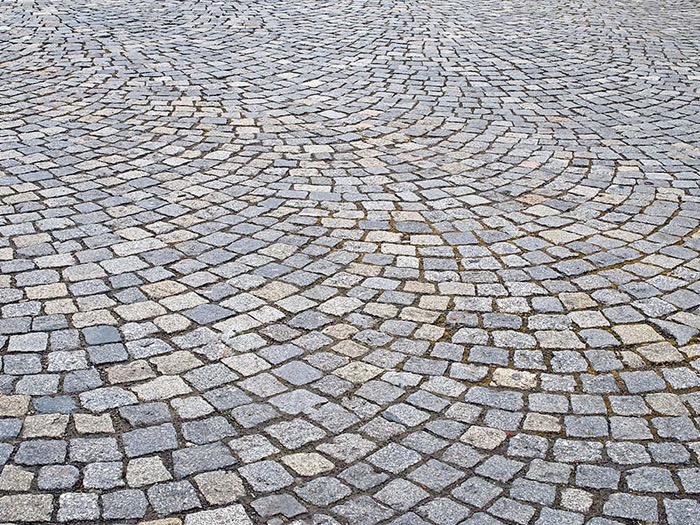Pavements

"Those weaned on concrete should struggle to absorb it all."
The flight paths into and out of Denver International Airport have not yet been paved, as evidenced by the routine insistence by every pilot of every arriving and departing flight that cabin service be either suspended three quarters of an hour before landing or delayed for a similar period after takeoff. These departures and arrivals prove to be white knuckle affairs for everyone except the flight crew, and even they give their seat belts an extra snugging tug. I find myself anxiously anticipating every departure and every return before finally submitting to the necessity of experiencing this ordeal, though I don't like or appreciate a minute of these adventures. ©2019 by David A. Schmaltz - all rights reserved
In the US, pavements tend toward the uniformly boring. Asphalt or concrete, as smooth as a baby's behind and as uniform as mass production can muster, marred only by chipping, cracking, or upheaving roots. Other parts of the world employ different materials, most notably cobblestones, a history of the fabrication of which might mirror the advance of civilization itself. The older cities of Europe each employ cobblestone as their primary pavement, though roads and sidewalks employing this material cost orders of magnitude more to fabricate and maintain. The stones seem to be held in place with sand, gravity, and an ingenuity more primitive and perhaps more brilliant than that which created any alternative paving.
My feet feel the cobbles' presence beneath them. In my super-thin-soled Barefoot® shoes, I can feel every imperfection massaging my soles. I walk gingerly, as if padding along a particularly well-trod trail, only very occasionally finding a disturbing prominence underfoot. By the end of a day's touring, my feet feel enlivened, which I contrast to how fragmented they feel after a day spent treading atop travertine or any other smooth-finished pavement. Car tires hum over cobbled streets. Rain partially seeps right through. I imagine the earth beneath breathing, still an integral part of civilization instead of cordoned off as a feral opponent of it.
I brought one treasured souvenir back from our recent visit to The Continent, a small hand-hewn cobblestone from a Prague side street. Sometimes, an edge of the surface will bulge and displace a few stones. I took this treasure from one of those places where a few stones littered the otherwise smooth-ish surface. I deeply appreciate the craftsmanship displayed in a finished cobble surface. The stones often seem to have been laid in arcs which seamlessly melt into each other to produce a most visually pleasing pattern. I have spent some time watching workmen repairing cobble pavement. They work on their knees, employing mallets to hammer each triangular stone precisely into place before sweeping heavy sand into the spaces between stones then brushing the top surface clean. It's painstaking effort, evidence of a deep respect for tradition as well for the surface covered.
Pavement's nothing particularly noteworthy in the US, most noticeable in its absence, like along the flight paths into and out of Denver International, or in its deterioration. Driving up the foothills last night, we found a fresh pothole that had not been there before we left two weeks ago. It seems that some lane is always undergoing renovation, a quick hot patch which seems to almost as quickly wear away. Some of the cobbled roadways in Italy have survived more than two millennia since Roman slaves first laid down their stones, a permanence other pavements can only envy.
An American in Paris might notice a case of Cobblefoot intruding on their touring should they wear the wrong shoes, ones too stiff to conform to the variety underfoot or too loose to stay put through the lumps and swells. It's hobbling, leaving aching ankles and sore toes. The American foot, even properly shod, isn't accustomed to such variety underfoot, no more than the American eye is used to such visual variety surrounding them there. One might be well-advised to find a small square which dates to the late middle ages and simply sit and absorb the variety surrounding them, for to attempt to tromp through it while gawking will most probably result in at least a minor case of cobblefoot or cobble-brain, a dizzying resulting from too much symmetrical imperfection perfectly harmonizing. Those weaned on concrete should struggle to absorb it all.


